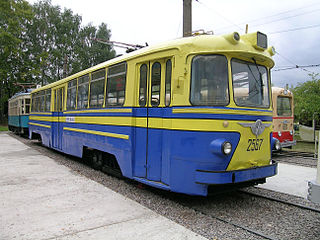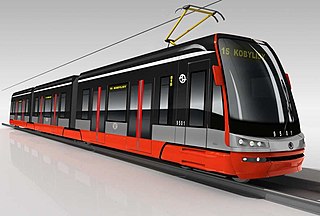
The PCC is a tram design that was first built in the United States in the 1930s. The design proved successful domestically, and after World War II it was licensed for use elsewhere in the world where PCC based cars were made. The PCC car has proved to be a long-lasting icon of streetcar design, and many remain in service around the world.

The LM-49 is the Soviet motor four-axle tramcar. The first prototype of this vehicle was built in 1949 at the Leningrad Wagon Repair Plant. "LM" means Leningrad Motor tramcar. These tramcars were utilized in Leningrad itself and some other Soviet cities such as Minsk, Gorky], Novokuznetsk and Magnitogorsk. VARZ produced in total 287 LM-49s for Leningrad and 113 for other cities.

MTV-82 is a Soviet four-axle tramcar.

The LM-57 is the Soviet motor four-axle tramcar. First prototype of this vehicle was built in 1957 at the Leningrad Wagon Repair Plant. "LM" means Leningrad Motor tramcar. The VARZ produced nearly 800 LM-57s in 1957–1968.

The 71-608 is a Russian motor four-axle high-floor tramcar. These rail vehicles are produced by Ust'-Katav Vagon-building plant. "KTM" means Kirov Motor Tramcar. This abbreviature was producer's official trademark before 1976, when new designation system for tram and subway rolling stock was introduced in the Soviet Union. After official abandoning KTM trademark it still lives in everyday conversations of Russian tram workers and enthusiasts.

The Tramway Français Standard (TFS) is a type of tram designed and manufactured by Alstom for use on various tramway systems in France. The TFS is no longer in production, having been superseded by the Alstom Citadis range of tramcars.

The T3 is a type of Czech tramcar produced by ČKD Tatra. A late-2000s study conducted on the Prague tram system has shown 98.9% reliability, the best of the Prague tram system fleet. During its period of production between 1960 and 1999, 13,991 powered units and 122 unpowered trailers were sold worldwide.

LVS-86 is a model of tramcar developed at the Leningrad Tram Manufacturing Plant in the former Soviet Union. LVS stands for "Leningrad-made articulated tram" in Russian, and 86 refers to the model year. The design was based on the LVS-80 tramcar. 473 LVS-86s were built from 1987 until 1997. LVS-86s currently run in Saint Petersburg and formerly in Arkhangelsk. Tram operation in Arkhangelsk ceased in July 2004.

The Saint-Étienne tramway is a tram system in the city of Saint-Étienne in the Rhône-Alpes (France) that has functioned continuously since its opening in 1881. The first tramway line was steam-operated and was opened by the Chemins de Fer à Voie étroite de Saint-Étienne (CFVE) on 4 December 1881, stretching for 5.5 km between La Terrasse and Bellevue. The CFVE took over the Compagnie des Tramways Électriques de Saint-Étienne lines and discontinued the use of steam in 1912.

The W-class trams are a family of electric trams built by the Melbourne & Metropolitan Tramways Board (MMTB) between 1923 and 1956. Over the 33 years of production, 752 vehicles spanning 12 sub-classes were constructed, the majority at the MMTB's Preston Workshops.

Škoda 15T is a 100% low-floor multiple-unit tram developed by VUKV a.s. and built by Škoda Transportation in Pilsen for the Prague tram network. It was a successor to the Škoda 14 T, featuring articulated bogies and more power to correct for problems found during the operation of the 14 T. The 15T has articulated bogies at either end of the train, and Jacobs bogies between the segments. The tram has two double-doors in each segment to allow fast boarding of passengers, and one extra side door leading to the driver's cabin.

Tatra KT4 is the name of a four-axle type articulated tramcar developed by the Czech firm ČKD Tatra. The first pre-production vehicles entered service in Potsdam in 1975, with the first production vehicles in 1977. A total of 1,747 units were built, with initial deliveries to East Germany (DDR) and later to the USSR and SFR Yugoslavia. KT4 variants were built for both standard gauge and metre gauge tramways. Production of the KT4 tramcar was halted in 1991 due to worldwide economic and political changes at the time. Production was briefly resumed in 1997 to construct the last 20 units for Belgrade, Serbia.

The Bern tramway network is a network of tramways forming part of the public transport system in Bern, the capital city of Switzerland. In operation since 1890, it presently has five lines, one of which incorporates the Bern–Worb Dorf railway.

Tatra T6B5 is a Czechoslovak-built high floor four axle tram with a pulse-width-modulation ('chopper') speed control. This model of tram was produced by CKD Praha in Smíchov, Prague in the period of 1983–1995, following one year in Zličín until 1996. After ČKD Praha went bankrupt, the final assembly and sale of incomplete trams were managed by Inekon Trams until 2007. The last four trams were supplied to the city of Ufa by late 2007. About 1,150 tramcars of this model were produced. In the former Soviet Union, it is also known as Т-3М. In 2015 most of these trams were used in Russia, Belarus, Ukraine, and Uzbekistan.

The Avdiivka tram opened August 23, 1965. Due to the ongoing War in Donbass the transport system has not operated since 2015 despite attempts to restart operations, with the last such attempt being in 2017.

The Ust-Katav Wagon-Building Plant, officially the Ust-Katavskiy Carriage Works named after S. M. Kirov is a railroad carriage works in Ust-Katav, Chelyabinsk Oblast, Russia.

71-931 "Vityaz" is a Russian three-unit six-axle 100% low-floor tram car created by LLC "PK Transportnye Sistemy" and manufactured in cooperation by PK TS and Transmashholding at the facilities of the Tver Carriage Works. Currently exists in two versions: the basic model Vityaz and 71-931M Vityaz-M modification with modified front and rear mask, different interior and Russian-designed traction motors. In operation in St. Petersburg, Krasnodar and Moscow's Bauman, Oktyabrskoye and Rusakov depots.

Timiș 2 were a series of tram vehicles built in Timișoara, Romania, initially by the Timișoara Transport Company, and later by Electrometal Timișoara.

The Electroputere (EP) V54 was a tram series produced by Electroputere of Craiova, in the (then) People's Republic of Romania in the 1950s, with a total of 265 units built, excluding the 37 units of the earlier V951 Festival tramcars, produced by URAC Bucharest. Inspired by the PCC streetcar, the name comes from the Romanian "Vagon 54", translated to as "Tramcar model year 1954".

The KTM-5, later known as the 71-605, is a Soviet tram model manufactured by UKVZ. First introduced in 1963, the KTM-5 was mass-produced between 1969 and 1992, with a total of 14,991 tramcars being made. KTM-5 trams were built exclusively for the Soviet Union, and therefore are currently only operating in post-Soviet states.




















